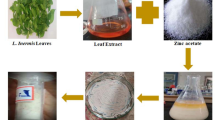Abstract
New Cu(II) and Ni(II) complexes of acetyl coumarin derivatives with gatifloxacin were synthesized. Characterization of the complexes was carried out by elemental analysis, FT-IR, FAB-MS, electronic spectra and magnetic measurement along with thermo gravimetric studies. Thermal study reveals the absence of coordinated water molecule in case of Cu(II) complexes. All the Cu(II) complexes were found more potent antibacterial activity compared to Ni(II) complexes. The antituberculosis data have shown that copper conjugation may be advantageous in designing highly effective drugs for antitubercular therapy. These complexes were also found to be potent antioxidizing agents comprising radical scavenging capability and ferric reducing abilities.




Similar content being viewed by others
References
Ahirrao P (2008) Recent developments in antitubercular drug. Mini Rev Med Chem 8:1441–1451
Al-Resayes SI, Shakir M, Abbasi A, Amin KMY, Lateef A (2012) Synthesis, spectroscopic characterization and biological activities of N4O2 Schiff base ligand and its metal complexes of Co(II), Ni(II), Cu(II) and Zn(II), Spectrochim. Acta Part A 93:86–94
Anacona JR, Toledo C (2001) Synthesis and antitubercular activity of palladium and platinum complexes with fluoroquinolones. Trans Met Chem 26:228–231
Appendino G, Mercalli E, Fuzzati N, Arnoldi L, Stavri M, Gibbons S, Ballero M, Maxia A (2004) Chemical composition and in vitro activity of plant extracts from ferula communis and Dittrichia viscosa against postharvest fungi. J Nat Prod 67:2108–2110
Babbs CF (1990) Oxygen radicals in ulcerative colitis. Free Radic Biol Med 8:191–200
Balhausen CJ (1962) Introduction to ligand fields. McGraw Hill, New York
Bauernfeind A (1997) Comparison of the antibacterial activities of the quinolones Bay 12-8039, gatifloxacin (AM 1155), trovafloxacin, clinafloxacin, levofloxacin and ciprofloxacin. J Antimicrob Chemother 40:639–651
Beraldo H, Gambinob D (2004) The wide pharmacological versatility of semicarbazones, thiosemicarbazones and their metal complexes. Mini Rev Med Chem 4:31–39
Blois MS (1958) Antioxidant determinations by the use of stable free radical. Nature 26:1199–1200
Blondeau JM, Laskowski R, Bjarnason J, Stewart C (2000) Comparative in vitro activity of gatifloxacin, grepafloxacin, levofloxacin, moxifloxacin and trovafloxacin against 4151 Gram-negative and Gram-positive organisms. Int J Antimicrob Agents 14:45–50
Carballo R, Castineiras A, Covelo B, Garcia-Martinez E, Niclos J, Vazquez-Lopez EM (2004) Solid state coordination chemistry of mononuclear mixed-ligand complexes of Ni (II), Cu (II) and Zn (II) with α-hydroxycarboxylic acids and imidazole. Polyhedron 23:1505–1518
Chulvi C, Munoz MC, Perello L, Ortiz R, Arriortua MI, Via J, Urtiaga K, Amigo JM, Ochando LE (1991) Coordination behavior of cinoxacine: synthesis and crystal structure of tris (cinoxacinate) cobaltate(II) of sodium hexahydrate (HCx = 1-ethyl-4(1H)-oxo-(1,3) dioxolo-(4,5g) cinnoline-3-carboxylic acid). J Inorg Biochem 42:133–138
Creaven BS, Egan DA, Kavanagh K, McCann M, Noble A, Thati B, Walsh M (2006) Synthesis, characterization and antimicrobial activity of a series of substituted coumarin-3-carboxylatosilver(I) complexes. Inorg Chim Acta 359:3976–3984
Da Silva AD, De Almeida MV, De Souza MVN, Couri MRC (2003) Biological activity and synthetic metodologies for the preparation of fluoroquinolones, a class of potent antibacterial agents. Curr Med Chem 10:21–39
Datta P, Mukhopadhyay AP, Manna P, Tiekink ERT, Sil PC, Sinha CJ (2011) Structure, photophysics, electrochemistry, DFT calculation, and in vitro antioxidant activity of coumarin Schiff base complexes of Group 6 metal carbonyls. Inorg Biochem 105:577–588
De Souza MVN (2005) New fluoroquinolones: a class of potent antibiotics. Mini Rev Med Chem 5:1009–1017
De Souza RFV, De Giovani WF (2004) Antioxidant properties of complexes of flavonoids with metal ions. Redox Rep 9:97–104
Deacon GB, Philips RJ (1980) Carboxylate as the protonation site in (Peroxo)diiron(III) model complexes of soluble methane monooxygenase and related diiron proteins. Coord Chem Rev 33:227–250
Egan DA, James P, Cooke D, O’Kennedy R (1997) Cytotoxic activity of new acetoxycoumarin derivatives in cancer cell lines. Cancer Lett 118:201–211
Figgis BN, Lewis J (1960) Modern coordination chemistry. In: Lewis J, Wilkins RG (eds) Principles and methods. Interscience, New York
Finn GJ, Kenealy E, Creaven BS, Egan DA (2002) 7,8-Dihydroxycoumarin inhibits A549 human lung adenocarcinoma cell proliferation by inducing apoptosis via suppression of Akt/NF-κB signaling. Cancer Lett 183:61–68
Fylaktakidou KC, Hadjipavlou-Litina DJ, Litinas KE, Nicolaides DN (2004) Cytotoxic activity of new acetoxycoumarin derivatives in cancer cell lines. Curr Pharm Des 10:3813–3833
Gomes AJ, Lunardi CN, Gonzalez S, Tedesco AC (2001) The antioxidant action of Polypodium leucotomos extract and kojic acid: reactions with reactive oxygen species. Braz J Med Biol Res 34:1487–1494
Jain S, Jain NK, Pitre KS (2002) Bio-inorganic studies on the Fe(II) sparfloxacin complex. Met Based Drugs 9:1–8
Ji HF, Zhang HY (2004) A new strategy to combat Alzheimer’s disease. Combining radical-scavenging potential with metal-protein-attenuating ability in one molecule. Chem Res Toxicol 17:471–475
Kang DG, Yun CK, Lee HSJ (2003) Identification and characterization of antioxidants from Sophora flavescens. Ethnopharmacol. 87:231–236
Kapoor P, Singh RV, Fahmi NJ (2012) Preparation, spectroscopic characterization and biological evaluation of metal complexes with schiff base derived from benzofuran and coumarin moieties. Coord Chem 65:262–277
Kharadi GJ, Patel KD (2010) In-vitro antimicrobial, thermal and spectral studies of mixed ligand Cu(II) heterochelates of clioquinol and coumarin derivatives. Appl Organomet Chem 24:332–337
Kidane AG, Salacinski H, Tiwari A, Bruckdorfer KR, Seifalian AM (2004) Anticoagulant and antiplatelet agents: their clinical and device application(s) together with usages to engineer surfaces. Biomacromolecules 5:798–813
Kontogiorgis CA, Savvoglou K, Hadjipavlou LDJ (2006) Evaluation of natural substances from Evolvulus alsinoides L. with the purpose of determining their antioxidant potency. J Enzyme Inhib Med Chem 21:21–29
Koshy J, Das VGK, Balabaskaran S, Ng SW, Wahab N (2000) High in-vitro antitumour activity of triphenyltin coumarin 3-carboxylate and its coordination complexes with monodentate oxygen donor ligands against the epstein barr virus (EBV)-DNA positive Raji and the P-388 murine leukaemia cell lines, and evidence for the suppression by organotin of the early antigen complex in the EBV lytic cycle. Met Based Drugs 7:245–251
Lien EJ, Ren S, Bui HH, Wang R (1999) Flavonoid B-ring chemistry and antioxidant activity: fast reaction kinetics. Free Radic Biol Med 14:285–294
Lin HC, Tsai SH, Chen CS, Chang YC, Lee CM, Lai ZY, Lin CM (2008) Structure-activity relationship of coumarin derivatives on xanthine oxidase-inhibiting and free radical-scavenging activities. Biochem Pharmacol 75:1416–1425
Nakamoto K (1986) Infrared and Raman spectra of inorganic and coordination compounds, 4th edn. Wiley Interscience, New York
Patel JC, Dholariya HR, Patel KS, Patel KD (2012a) Spectral, thermal, biological and multi-heating rate kinetic properties of Cu(II) complexes containing N2O2 donor ligands: 1,10-phenanthroline and acyl coumarins. Appl Organomet Chem 24:332–337
Patel KS, Patel JC, Dholariya HR, Patel KD (2012b) Multiple heating rate kinetic parameters, thermal, X-ray diffraction studies of newly synthesized octahedral copper complexes based on bromo-coumarins along with their antioxidant, anti-tubercular and antimicrobial activity evaluation, Spectrochim. Acta Part A 96:468–479
Patonay T, Litkei G, Bognar R, Eredi J, Miszti C (1984) Synthesis, antibacterial and antifungal activity of 4-hydroxycoumarin derivatives, analogues of novobiocin. Pharmazie 39:86–91
Psomas G, Dendrinou-Samara C, Philippakopoulos P, Tangoulis V, Raptopoulou CP, Samaras EL, Kessissoglou DP (1998) CuII-herbicide complexes: structure and bioactivity. Inorg Chim Acta 272:24–32
Rattan A (2000) In: Churchill BI (ed) Antimicrobials in laboratory medicine. Livingstone, New Delhi
Sadeek AS, El-Shwiniy WH (2010) Metal complexes of the fourth generation quinolone antimicrobial drug gatifloxacin: synthesis, structure and biological evaluation. J Mol Struct 977:243–253
Sandbhor U, Padhye S, Billington D, Rathbone D, Franzblau S, Anson CE, Powell AKJ (2002) Inorg Biochem 90:127–136
Sigel A, Sigel H, Sigel RKO (2006) Metal ions in life sciences. Wiley, Chichester
Singh K, Kumar Y, Puri P, Kumar M, Sharma C (2012) Cobalt, nickel, copper and zinc complexes with 1,3-diphenyl-1H-pyrazole-4-carboxaldehyde Schiff bases: antimicrobial, spectroscopic, thermal and fluorescence studies. Eur J Med Chem 52:313–321
Sousa I, Claro V, Pereira JL, Amaral AL, Silva LC, De Castro B, Feio MJ, Pereira E, Gameiro PJ (2012) Synthesis, characterization and antibacterial studies of a copper(II) levofloxacin ternary complex. Inorg Biochem 110:64–71
Trommel JS, Marzilli LG (2001) Synthesis and DNA Binding of novel water-soluble cationic methylcobalt porphyrins. Inorg Chem 40:4374–4384
Turel I, Leban I, Bukovec N (1997) Crystal structures and characterization of the Bismuth (III) compound with quinolone family member (Ciprofloxacin). Antibacterial study. J Inorg Biochem 66:241–245
Turel I, Golobic A, Klavzar A, Pihlar B, Buglyo P, Tolis E, Rehder D, Sepcic KJ (2003) Interactions of oxovanadium(IV) and the quinolone family member—ciprofloxacin. Inorg Biochem 95:199–207
Vincenzi FF, Thomas HR (1999) Stobadine: bellwether of a broader view of drug actions. Life Sci 65:1857–1864
Weber E, Marten J, Seichter W (2009) Synthesis and crystal structures of the chelating ligand 3-[(2,6-dimethylphenyl)hydrazono]-1,1,1-trifluoropentane-2,4-dione and its complex with copper(II). J Coord Chim 62:3401–3410
Acknowledgments
We articulate our appreciation to authorities of V. P. & R. P. T. P. Science College, Sardar Patel University, Vallabh Vidyanagar, India for providing infrastructural & chemical facilities. We are greatful to Department of Science and Technology (DST) Delhi, India for providing financial support to one of the author (JDB) in the form of INSPIRE fellowship. We are thankful to the Director, SICART, Vallabh Vidyanagar for spectral analysis facility. Authors are also grateful to the Microcare laboratory, Surat for providing bio-analysis facility.
Author information
Authors and Affiliations
Corresponding author
Electronic supplementary material
Below is the link to the electronic supplementary material.
Rights and permissions
About this article
Cite this article
Patel, J., Dholariya, H., Patel, K. et al. Cu(II) and Ni(II) complexes of coumarin derivatives with fourth generation flouroquinolone: synthesis, characterization, microbicidal and antioxidant assay. Med Chem Res 23, 3714–3724 (2014). https://doi.org/10.1007/s00044-014-0943-y
Received:
Accepted:
Published:
Issue Date:
DOI: https://doi.org/10.1007/s00044-014-0943-y




